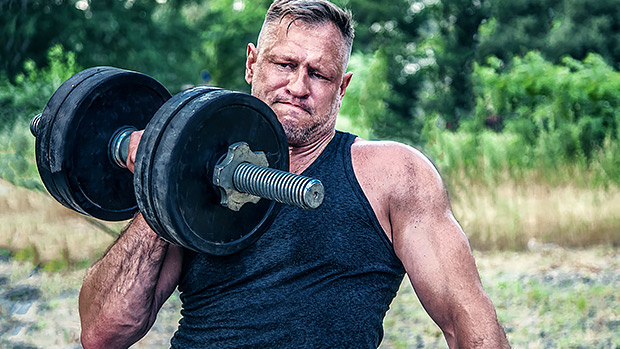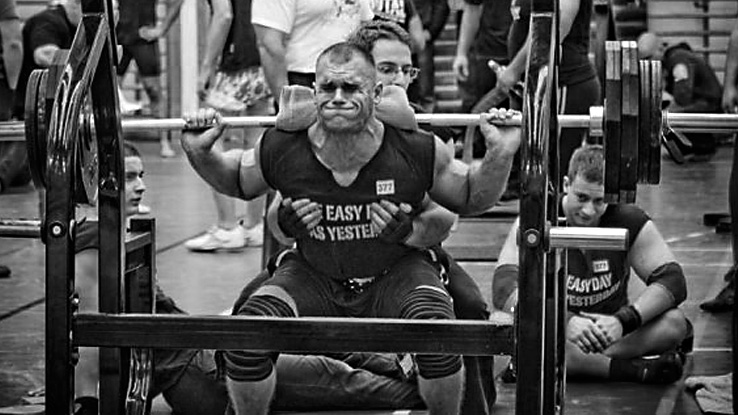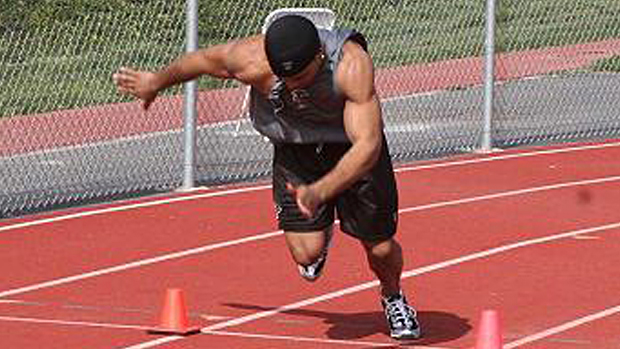A few weeks ago we asked a bunch of great trainers to design a workout using only a single medium-weight dumbbell or kettlebell. (Check out their ideas here.) Now, four more top coaches have given us their best plans:
You're obviously limited by weight and exercise variation. So view these as positive constraints by selecting the "most value for time" exercises. Also, use a workout format that's challenging, but also keeps morale high with a descending rep scheme. Try this:
- For time: 10-9-8-7-6-5-4-3-2-1
- Time cap: 25 minutes
Do ten reps of each exercise with no rest between them, then nine, then eight, until you hit one rep of each. See how fast you can get it done. Set a time cap of 25 minutes and stop there even if you're not finished completing all the reps.
- Rear-Foot Elevated Split Squat (L)
- Rear-Foot Elevated Split Squat (R)
- Goblet Squat
- Z-Press (L)
- Z-Press (R)
- Sit-Ups (feet anchored around dumbbell)
- Renegade Row (L)
- Renegade Row (R)
- Close Grip Push-Up (with hands on dumbbells)
The rear-foot elevated split squat is the best exercise to train legs when you only have a single dumbbell. Immediately following it with the goblet squat will provide a serious leg pump. The Z-press is one of my favorite overhead pressing variations and the most challenging way to press a dumbbell.
After the Z-press, immediately go to sit-ups. I chose the sit-up because it almost serves as a rest period and allows you to keep moving, which improves the flow of the workout.
Remain on the ground and transition to renegade rows. I love this exercise because it challenges your lats and core stability. Take a wide stance with your feet and keep your shoulders as square as possible. Easier said than done, trust me.
Finally, finish each round with a close-grip strict push-up with your hands on the ends of the dumbbell. The push-up is a far more effective stimulus than a single arm dumbbell bench press or floor press if you only have access to a moderate to light weight.
This simple dumbbell-only workout will get you the most value for time. It hits every major muscle and has an inherent conditioning effect. Get after it and enjoy! – Tanner Shuck
Having one moderate-weight kettlebell is actually pretty damn good. You can still create a workout that'll have you putting in work, sweating, and covering all of these factors in an hour or less:
- Explosiveness
- Strength
- Muscle Building (Time Under Tension)
- Conditioning
Here's one way to do it:
| Exercise | Sets | Reps | |
|---|---|---|---|
| A. | Kettlebell Deadlift Jump | 4 | 6-8 |
| B1. | Single-Leg Squat to Box | 4 | 6-8/side |
| B2. | 3-Point Kettlebell Row (4 second eccentric) | 4 | 10/side |
| C1. | Offset Single-Leg RDL with Knee Drive | 3 | 10/side |
| C2. | 1-1/2 Rep One-Arm Kettlebell Floor Press | 3 | 10/side |
| D. | Density Training | 10 min.* | |
| 1-1/2 Rep Goblet Squat | 8 | ||
| Single-Arm Clean & Press | 5/side | ||
| Reverse Crunch with Kettlebell Pullover | 6 | ||
| E. | Kettlebell Swings (EMOM)** | 10 min. | 12 |
* Repeat as many sets within the allotted time of the three density exercises. If you repeat this workout, progress by getting more sets or rounds in the 10-minute timeframe. Every 2-3 weeks, increase the amount of time in the set by 2 minutes.
** (EMOM) every minute on the minute.
Here's what those exercises look like. – Luka Hocevar
If you've only got a medium-weight dumbbell or kettlebell, you're probably not going to boost your maximal strength. What you can do is build muscle, improve your strength-endurance (the ability to be strong over an extended period of time), and build your work capacity (doing more work in less time).
For growth, choose harder exercises. Make it suck by pushing yourself close to failure, ramping up the reps, and accumulating volume. For strength-endurance and work capacity, use shorter rest periods (density training).
These strategies reduce the amount of load needed to produce a training effect while kick-starting a cascade of positive hormonal events post-training.
This workout consists of two blocks: one for building muscle and one for increasing muscular endurance and work capacity.
Block One (Relative Intensity Circuit): 3-4 Rounds
This is about maximizing the amount of load the working muscles need to take on without a ton of actual weight. The goal is to build muscle through mechanical tension and muscle damage. You won't see any rep prescriptions here because you'll do as many reps for each exercise as it takes to get close to technical failure.
Exercises:
- A. Wall-Reference Split Squat
- B. Wall-Reference Single-Leg Deadlift (SLDL)
- C. One-Arm Bridge Press with Eccentric Flye
- D. Staggered One-Arm Bent-Over Row with Dead Stop
Here's how the whole thing would look:
Go through A-D in a circuit fashion for 3-4 rounds, pushing each set to technical failure (or close to it) while resting only as needed. Use a slow and controlled eccentric on every rep (between 3-5 seconds) while establishing a strong mind-muscle connection.
Here's a closer look at each exercise...
A. Wall-Reference Split Squat
Drive the back foot into the wall to create high levels of muscular activation and crippling amounts of tension in the quads, glutes, and hamstrings.
Set up with a regular split-squat stance (with a slightly positive shin angle) and place your back foot against the wall with your toes barely touching the ground. Begin by forcefully driving that foot into the wall to create maximal tension, then "spiral" the kettlebell or dumbbell toward your midline. Maintain that position and tension throughout the full range of motion (ROM) of each rep.
B. Wall-Reference Single-Leg Deadlift
Equipment or no equipment, there might not be any other exercise that can blow up your backside like this bad boy.
Set up with your front foot a tad closer to the wall than it was during the split squats, then drive that back foot into the wall. Begin by sitting your hips back with a slight inward spiral of the back knee. From there, think about stacking your nose and middle knuckle over your big toe (to make sure you move in a straight line) throughout each rep.
Here's an alternative for A and B:
If you don't want to scuff up your walls, swap the first two exercises for the reverse lunge to SLDL.
C. One-Arm Bridge Press with Eccentric Flye
The bridging action allows for a bigger ROM than regular floor presses, while the eccentric flye overloads the chest with more load than regular flyes (typically). In addition, the leg drive and stability demands reinforce a strong brace that can carry over to the barbell bench press.
Begin by driving your hips up, then press the kettlebell or dumbbell up while maintaining that hip extension. At the top of the press, bring the weight out to your side and lower it with a slightly bent elbow. After touching the ground, bring your arm back toward your midline and repeat.
D. Staggered One-Arm Bent-Over Row with Dead Stop
Using a slightly open staggered stance allows for a large ROM that's conducive to muscle growth. Throwing the dead stop into the mix eliminates momentum and forces the back to contract forcefully at the beginning of each rep.
Set up with a semi-wide, staggered stance and your hips hinged back. Then open up your back leg to give your arm more room to travel. From that position, perform each row with a slight shift from internal-to-external rotation. Pause for a second on the ground, then row the weight back up.
Block Two (Density Circuit): 20-30 minutes
This is about building your strength-endurance and work capacity while accruing metabolic stress. The goal is to get as much work done as possible in a short period of time.
Exercises:
- A. Kettlebell or Dumbbell Swing
- B. One-Arm Push Press with Slow Eccentric
- C. Heels-Elevated Goblet Squat
- D. Hand Release Push-Up
Here's how the whole thing would look:
Go through A-D for a set period of time (between 20-30 minutes), racing against the clock to get through as many rounds as possible.
On the first round, go for as many reps as possible on each exercise, then – voila – you have your target rep counts. On every round after that, try to hit that initial rep count. Don't worry about tempos; just blast each set and keep things moving.
Here's a closer look at each exercise...
A. Kettlebell Swing
On top of building your work capacity, swings elicit high levels of muscle activity in the glutes, erectors, and anterior core, which meshes well with their capacity to be done with high amounts of volume.
With the kettlebell out in front of you, begin by hinging at the hips, then snap the kettlebell back. From there, alternate between flexion and extension at the hips while keeping the kettlebell above your knees. (If using a dumbbell, hold one end of it.)
B. One-Arm Push Press with Slow Eccentric
Use the lower body to help drive the dumbbell or kettlebell overhead. This allows you to get more reps in than otherwise possible, which means you can accumulate more volume with the same load. The controlled negative is where the magic happens since it causes more muscle damage and increases time under tension.
Use a slightly staggered stance to minimize arching at the low back, then initiate the movement by dipping down to create some momentum before exploding the implement upwards. Take 3-5 seconds to lower the weight while tucking the elbow back toward the midline. (If you get an uneven number of reps between sides, use a rest-pause protocol to make up the difference.)
C. Heels-Elevated Goblet Squat
By elevating the heels, the quads get smoked especially hard since it encourages an upright torso position and more positive shin angles.
Set up with your heels elevated on a 3-5 inch surface. Keep the weight tucked into your chest and stop slightly short of lockout at the top of each rep to maintain tension.
D. Hand Release Push-Up
Hand-release push-ups start from a dead stop, which – on top of increasing difficulty – requires a stronger initial pectoral contraction at the beginning of each rep. They also have a greater ROM than standard push-ups (by about 10%), which maximizes pec recruitment.
Get into a push-up position, then descend under control until your chest hits the ground. From there, squeeze your shoulder blades together and drive your elbows up so your hands come off the ground, then bring them back down before pushing up. Make sure to "push" yourself away from the ground at the top so that your shoulder blades fully protract.
Tips
- Do 2-3 sets of a couple of power movements like jumps, sprints, plyo push-ups, and/or dumbbell or kettlebell snatches before each workout.
- If you're short on time, you can do either block as a standalone workout.
- If you're doing these workouts for an extended period of time, make density your primary marker of progression, then switch up the movements every 3-4 weeks. – Charley Gould
This one's a full-body, 45-60 minute workout for intermediate lifters. Use the prescribed tempo. Neglecting it during exercises is like neglecting cooking times for recipes. How long your muscles are working during a set has a huge impact on the results you get.
This contains three supersets, so get adequate rest and don't rush between them. After the first exercise, catch your breath and make your way to the next set. You'll get more out of the next exercise.
Go to technical failure – when you can't complete any more perfect reps – rather than complete failure. Don't cheat your way through the last couple of reps with awful technique.
A1. Rear and Front Foot Elevated Split Squat
Do 3 sets of 8 each leg. Use a 4-0-1 tempo: 4 seconds down, 0 seconds at the bottom, and 1 second up.
You can use a couple of books or pillows to elevate your feet if you don't have access to a bench. Elevating your back foot helps glute engagement. Elevating your front foot helps quad engagement. Elevating both is just hell.
A2. Tall Kneeling Single-Arm Arnold Press
Do 3 sets of 8 each arm (2-0-1 tempo).
Rest two minutes after completing both exercises.
A kneeling stance (both knees on the floor) reduces leg drive and increases core demand in combination with the unilateral press.
B1. High Birddog Dumbbell Row
Do 3 sets of 8 each arm (4-0-2 tempo).
Control the eccentric (lowering) portion of the movement. The whole point of this exercise is to introduce anti-rotation core stability while rowing. By minimizing your base of support, you're increasing the demand of the exercise.
B2. Hollow Position Single-Arm Floor Press
Do 3 sets of 8 each arm (2-0-1 tempo).
Rest 1-2 minutes after completing both exercises.
The goal isn't to get stronger. It's to create maximal tension and demand on your muscles. One of the ways to do that is to eliminate leg assistance during a pressing exercise.
Yes, lifting your legs on the bench press with a barbell is pointless when it comes to getting stronger because you can't lift maximal effort weights without leg drive. But when using a medium-sized weight, a hollow position is great for increasing the demand of an exercise and overall muscular tension.
C1. Staggered RDL
Do 3 sets of 10 each leg (2-0-1 tempo).
C2. Dumbbell Dead Bug
Do 3 sets of 5 each leg (2-0-2 tempo).
Rest 1-2 minutes after completing both exercises.
Keep your ribs braced down throughout your set to maintain core engagement. You shouldn't be able to sneak your hand underneath your low back, so keep it flat against the floor. Exhale as you stretch your limbs out and inhale as you return to your starting position.
D. Standing Dumbbell Hold
Do 3 sets of 30 seconds each arm
The further away the weight is from your body, the harder it is to stabilize your torso. This is an anti-rotation exercise so your core should be working really hard to stabilize your spine and maintain an upright "neutral" position.
Rest 30-60 seconds after both sides have been completed. – Dan North





